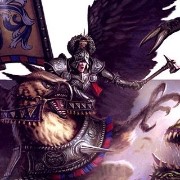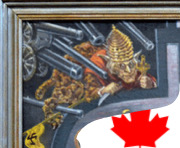|
is that one story about the english longbows outfiring otherwise superior french crossbows to win some battle(agincourt?) true
|
|
|
|

|
| # ? May 24, 2024 04:00 |
|
stumblebum posted:in terms of weapon development as a marker and cause of shifting of power from landed aristocracy to manufacturing bourgeoisie, what factors in particular made firearms the export commodity of choice over the crossbow, particularly for purchasing slaves during the triangle trade? were there productive differences that gave firearms an advantage over crossbows in terms of scale and/or flexibility? or was it more strategic/tactical concerns, where firearms had simply outpaced crossbows in terms of average combat effectiveness and thus desirability for exchange? In terms of technical performance, early firearms would penetrate armor and cover better than bows/crossbows, and shots are more lethal than arrows and bolts. Bows stuck around more for cavalry because it took a while to get economic (you can use wheelocks, but they're pricy) guns that can be used on horseback.
|
|
|
|
Question for the Turks. The gunpowder empires had to deal with this before the Europeans and a better example is the transition from traditional European slaves like Jannissaries (Turkey), Mamluks (Egypt), Ghilman/Ghulum (Iran) into being being brought up with the gunshot as they were former Cataphract/Knights. https://en.wikipedia.org/wiki/Night_Attack_at_T%C3%A2rgovi%C8%99te Ottomans famously setup an Ambush for Vlad the Impaler with this in mind using guns. That's the first actual people being setup with guns, it's an upgrade for the mounted cataphract who also had a recurve/crossbow, to have just a gun. https://en.wikipedia.org/wiki/Panjagan
|
|
|
|
Longbows used by a skilled user (and this is the important part) always had more range and higher rate of fire compared to European crossbows iirc. China and Korea had repeating crossbows but let's ignore those. Anyway, the issue there is to become a skilled user of a longbow you needed to practice many hours a week for your entire life. To become a skilled user of a crossbow, not so much.
|
|
|
|
Also the French did win a bunch of battles against English longbow, it's just that every so often they took an extremely stupid battle (hey instead of waiting for these guys to poo poo themselves to death let's charge heavy cavalry into a muddy chokepoint of prepared defenses without adequate skirmisher coverage so we can have a glorious victory) and reset the clock another decade. Also weren't repeating crossbows noticeably lower power and thus basically only useful for personal defense and close quarters?
|
|
|
|
Orange Devil posted:Longbows used by a skilled user (and this is the important part) always had more range and higher rate of fire compared to European crossbows iirc. China and Korea had repeating crossbows but let's ignore those. You would never use a long bow outside of European warfare. it wouldn't work in large open areas where speed and agility would be key.
|
|
|
|
StashAugustine posted:Also weren't repeating crossbows noticeably lower power and thus basically only useful for personal defense and close quarters? I mean, maybe, I dunno, they were also invented and produced 1000 years before the European crossbow so that might have something to do with it.
|
|
|
|
i miss frosted flake
|
|
|
|
Orange Devil posted:I mean, maybe, I dunno, they were also invented and produced 1000 years before the European crossbow so that might have something to do with it. Yeah tbc it was still an engineering marvel and a useful weapon for its purpose, just not the medieval machine gun some games portray it as
|
|
|
|
Ardennes posted:The Russians have been hitting hotels, you routinely get stories from the West complaining about it. Almost certainly, NATO has been taking casualties, it just they don't want to admit it for very clear reasons. The thinking it is makes Putin look dumb and weak, that's it. The West is unable to think of anything outside of PR moves
|
|
|
|
HouseofSuren posted:You would never use a long bow outside of European warfare. it wouldn't work in large open areas where speed and agility would be key. how long does a bow have to be to be a longbow? both india and japan has some pretty long bows
|
|
|
|
Cuttlefush posted:i miss frosted flake Who?
|
|
|
|
stumblebum posted:in terms of weapon development as a marker and cause of shifting of power from landed aristocracy to manufacturing bourgeoisie, what factors in particular made firearms the export commodity of choice over the crossbow, particularly for purchasing slaves during the triangle trade? were there productive differences that gave firearms an advantage over crossbows in terms of scale and/or flexibility? or was it more strategic/tactical concerns, where firearms had simply outpaced crossbows in terms of average combat effectiveness and thus desirability for exchange? crossbows are mechanically very complicated, they're like a mechanical watch as far as weapons go, so many things that can go wrong, hard to scale up production guns are very simple by comparison and the way they work requires them to be pretty durable that stuff matters a ton when most people using any given weapon might be illiterate or have never fought in their lives firearms require way less training before someone becomes deadly compared to bows/crossbows/etc that creates the potential for massive levees on demand for offensive military action in a way that the older systems and equipment didnt allow
|
|
|
|
stumblebum posted:in terms of weapon development as a marker and cause of shifting of power from landed aristocracy to manufacturing bourgeoisie, what factors in particular made firearms the export commodity of choice over the crossbow, particularly for purchasing slaves during the triangle trade? were there productive differences that gave firearms an advantage over crossbows in terms of scale and/or flexibility? or was it more strategic/tactical concerns, where firearms had simply outpaced crossbows in terms of average combat effectiveness and thus desirability for exchange? Stapleton, A Military History of Africa posted:THE COASTAL FOREST: SLAVES AND FIREARMS West Africa also had knights, who lost their social and political power when guns came along, hundreds of years later than in Europe. I'm not sure how many people know that, Stapleton, A Military History of Africa posted:Inhabiting what is now western Nigeria stretching from the savanna below the lower Niger River south to the coastal forest, Yoruba farmers produced a food surplus and began state formation around 1000 or 1100. Located in the fertile and well-watered border between savanna and forest that was suitable for cultivation and livestock, Ife became the original Yoruba city-state and produced enough food that some of its subjects became specialist artists producing wood and ivory carvings and metal castings. Ife inspired the formation of a series of similar states, each based on a major town. Because Ife's influence was based on its spiritual and cultural importance to the Yoruba, it did not maintain a standing army. Located on the savanna near where the Niger River enters the forest, the town of Oyo Ile was inhabited as early as the 700s and was an important trading center around 1535 when it was attacked by neighboring Nupe. As a result, the Oyo rulers fled west to Borgu, where they copied their Nupe enemies and other neighbors such as the Hausa by adopting cavalry warfare. By the early 1500s, they had established a new capital at Igboho, 65 kilometers west of the old one. During the late 1500s, they recaptured Oyo Ile and conquered the Yoruba city of Ilorin to the east. Expanding into the savanna gap to the west and southwest, Oyo became a major intermediary in the trade between coastal groups in the south and the Hausa in the north. Because Oyo's military power was based on cavalry, which dominated its open savanna homeland, yet tropical disease made it difficult to breed large horses in that area, their success came to depend on constantly acquiring horses from the north by exporting slaves. In addition, slaves played important roles in the Oyo state administration and military. Oyo established a semipermanent heavy cavalry force of 70 war leaders (Eso) who were appointed on merit by the ruling council and king. Each war leader provided a number of specialist soldiers such as heavy cavalry, sometimes slaves of northern origin, and archers. Initially, the kings of Oyo personally led their armies into battle; but during the wars with Nupe, one was accidentally drowned in a river and another narrowly avoided death in combat. Therefore, from around 1600, all military expeditions were led by an appointed supreme commander who was required to live outside the capital and was usually a provincial governor. To provide motivation, the Oyo state required that the leader of an unsuccessful military expedition commit suicide, and several failed commanders were executed in the late 1600s and 1700s. Oyo Ile was protected by a perhaps 10,000-strong metropolitan army, which included a palace guard made up of slaves who were commanded by a member of the ruling council and who provided most of the state's cavalry forces. Provincial governors were responsible for raising armies that consisted mostly of infantry to collect tribute or embark on imperial campaigns. Attempts by Oyo to expand southeast into the forest during the late 1500s and early 1600s were hindered by the area's lack of suitability for cavalry and resistance by Benin. Although Oyo's southern expansion was limited by the fact that its horses could not live permanently near the coast because of tropical disease, it began raiding south toward Dahomey in 1682 and invaded that coastal state several times in the early and mid-1700s. These conflicts pitted the Oyo cavalry, armed with lances, swords, and bows, against Dahomey's firearm-equipped infantry. In 1726, the smoke and noise of Dahomey's firearms frightened the horses of Oyo's all-cavalry invasion force and prevented them from launching what would have been a devastating charge. Dahomey forces also attempted to counter Oyo cavalry by fortifying their settlements with wooden and bush walls as well as ditches protected by European-made cannon. Oyo fighters responded by dismounting and launching determined infantry assaults on the forts that overwhelmed Dahomey forces after days of hard fighting. During the two protracted conflicts fought by these two states from 1726 to 1730 and 1742 to 1748, Oyo was unable to conquer Dahomey, and Dahomey was unable to prevent damage from Oyo raids. As a result, in 1748, Dahomey agreed to a humiliating settlement in which it became a tributary state of Oyo. Tell me if you've heard this one before, "Conflict between the king and his council weakened the state's power." Stapleton, A Military History of Africa posted:Conflict between the king and his council during the late 1700s weakened Oyo's power. In the 1790s, Afonja, the commander of Oyo's provincial armies and ruler of Ilorin, rebelled against the central government. Afonja's army took Oyo Ile in 1796, but when he was not named the new Oyo ruler, he declared Ilorin's independence. After two decades of inconclusive warfare between Oyo and Ilorin, Afonja, in 1817, gained assistance from the Sokoto Caliphate, which extended its Fulani-led jihad into Oyo, where there was a Muslim minority. Although Afonja initially benefited from this alliance, he was not a Muslim and in 1823, the Fulani jihadists under Abd al-Salam killed him and incorporated Ilorin into Sokoto. As early as the 1780s, Oyo was defeated by neighboring Borgu and Nupe, with the latter becoming part of Sokoto in the early 1800s. In the 1790s, the Egba, located south of Oyo and north of Lagos Lagoon, rebelled and broke from Oyo. In 1822, Owu (Oyo's main ally) was destroyed by forces from Ijebu and Ife. Dahomey reasserted its independence by cutting off Oyo's access to the coastal slave market at Porto Novo in 1807, ceasing payment of tribute in 1823, and seizing Oyo's most southern province of Egbado around 1830. Denied slave exports and unable to acquire horses from its hostile jihadist neighbors, Oyo collapsed and in 1833, its capital and major towns were sacked by Ilorin. It's three volumes, but covers the introduction of guns and changes in society in every part of Africa. It's a great read. and then what's interesting is, some of these African societies became so proficient with muskets, depending on when they got them, that they reached military parity with the Europeans, in rich parts of Africa had more guns and better than the Europeans. Then breechloading rifles came around and the Europeans had the advantage. Then those African societies started acquiring rifles and got very good at using them. Repeating rifles came along, those African societies eventually got those too. There's actually a reason why having the Maxim Gun, "and they have not", was so important. The British launched numerous expeditions into the unknown parts of East Africa on the rumour that some unscrupulous (French, American, German) trader was offering Maxim Guns to the natives. The European powers all reached agreements of varying formality that none of them were to ever give Maxim Guns to any African society, it was considered something like nuclear proliferation. DJJIB-DJDCT has issued a correction as of 22:12 on Mar 4, 2024 |
|
|
|
Megamissen posted:how long does a bow have to be to be a longbow? both india and japan has some pretty long bows If you're into bows I suggest this guy https://www.youtube.com/@ArminHirmer I always think English Long Bow first which is a very big bow, but they can be close to the same size as a recurve. I just don't know how horse riding with a long bow works. Think this kind of engagement. https://www.youtube.com/watch?v=FVaADXhnxuE&t=661s
|
|
|
|
If you want an idea of why they were scared, the Iroquois were the dominant military power in North America for over a century once they started getting large number of guns. There was no central authority interdicting traders and lots of unscrupulous whalers in the area around New Zealand, so the Maori got lots of guns and steel weapons and tools, and became incredibly powerful, while almost destroying their society (and the British colonies) in wars. The Japanese went from matchlock muskets to the Zero in less than a hundred years. The Indians went from making war by clattering schellenbaum and reciting poetry or whatever before battle to the best soldiers in the world.
|
|
|
|
I'm starting to think maybe martial prowess is material rather than racial?
|
|
|
|
Orange Devil posted:I'm starting to think maybe martial prowess is material rather than racial? Cultural. The Romans, never in their history are ever a dominant horse-riding force, ever, and they tried really hard. Atilla's forces attacked the Sassanians too and failed https://en.wikipedia.org/wiki/Hunnic_invasion_of_the_Sasanian_Empire out of every campaign the only Roman one to actually make it into the east, past the Zagros mountains, besides Alexander the Great who is not Roman. Is Marc Antony trying to siege a fortress in the Median province with Caesars plans. https://en.wikipedia.org/wiki/Antony%27s_Atropatene_campaign HouseofSuren has issued a correction as of 22:31 on Mar 4, 2024 |
|
|
DJJIB-DJDCT posted:If you want an idea of why they were scared, the Iroquois were the dominant military power in North America for over a century once they started getting large number of guns. There was no central authority interdicting traders and lots of unscrupulous whalers in the area around New Zealand, so the Maori got lots of guns and steel weapons and tools, and became incredibly powerful, while almost destroying their society (and the British colonies) in wars. The Japanese went from matchlock muskets to the Zero in less than a hundred years. The Indians went from making war by clattering schellenbaum and reciting poetry or whatever before battle to the best soldiers in the world. I would say that the people selling guns to indigenous folks are the most scrupulous Europeans by far.
|
|
|
|
|
HouseofSuren posted:Cultural. cultural martial characteristics and relative performance are materially driven the Romans didn't have a horse army because they weren't fighting on steppes & a horseback army can't work v. far from where the land can support the horses
|
|
|
|
That's not correct, the Roman's would hire steppe forces to protect that area, in replace of creating their own proper equivalency. Hence you have them losing to the Ostrogoths, the Visigoths, including the Alans. The whole reason knights even come to the Charlamagne Franks is because of those same Alan's. https://en.wikipedia.org/wiki/Goar https://en.wikipedia.org/wiki/Attaces https://en.wikipedia.org/wiki/Respendial 400 years later around 800 AD the Rustamids bring cataphractery to the west africans like the Songhai https://en.wikipedia.org/wiki/Rustamid_dynasty I'll point out something These are the same name in different Iranian cultures/times https://en.wikipedia.org/wiki/Attaces https://en.wikipedia.org/wiki/Arsaces_I_of_Parthia https://en.wikipedia.org/wiki/Artaxerxes_I HouseofSuren has issued a correction as of 22:42 on Mar 4, 2024 |
|
|
|
Also the Late Roman heavy cavalry was the most powerful striking arm of their military, and cataphracts were very rarely beaten. This is another boring materialist thing where you have to look at land with grazing potential.  Anthropogenic land use in Europe and surrounding areas at AD 800 simulated by four different modelling approaches: (a) the Kaplan et al. (2009) standard scenario; (b) the Kaplan et al. (2009) technology scenario; (c) the HYDE 3.1 database (Klein Goldewijk et al., 2010); (d), the Pongratz et al. (2008) maximum scenario. As for the Merovingian cavalry, when the Völkerwanderung happens, or doesn't, there are traditionally two subtypes of Germanic people "Horse" and "Foot", determined by how their elites fought. Saxons, famously, fought on foot. Many of the more eastern (and so either on the Eurasian steppe or in the Pannonian Basin) Germanic people fought on horseback, and were intermingled with Huns, Avars, Alans etc. Regardless, the Roman heavy cavalry tradition is pretty persistent in Frankia and elsewhere, Ystrad Clud, and so it's pretty easy to draw the line from the Dux and their retainers to Arthur and his knights and Charlemagne and the Paladins. Like all feudal systems, it's a hybrid anyway. There's Christian ritual, Germanic oath-based bonds, and Roman law. The material culture is also hybridized, but the arms and armour as well as much of the tack and bridle are notably related to late Roman forms. The real difference is the economic base and unifying political structure to raise cavalry mounts, produce large amounts of armour etc. There's no place in Europe where that can all be supported locally. Something needs to be imported, and often things need to be scaled back. Instead of 400–600 equites, a polity could produce maybe a few dozen men with both mounts and armour of some kind. However, the other polities were in the same situation, armies mostly consisted of men with no more than spears, axes and shields, so their relative military advantage, and so impact, was high all the way through. The economic limits of the new polities prevented large year-round armies, so we see levies form the bulk of fighters. Well, someone with training, a sword, and protection enjoys a huge advantage over just some guy with a spear and shield, and so Huscarls and other retinues have a big advantage too, and that's another thing that shapes social relations. Even on foot, again we look at the Danes, Saxons and Anglo-Saxons, an armoured man on foot who fights for a living has a huge advantage over a levy who doesn't. It's all material, but I don't think that makes it boring. DJJIB-DJDCT has issued a correction as of 22:51 on Mar 4, 2024 |
|
|
|
HouseofSuren posted:That's not correct, the Roman's would hire steppe forces to protect that area, in replace of creating their own proper equivalency. no like the kind of army that's useful in the steppes isn't useful around most of the mediterranean and vice versa its why the mongols didnt wash over all of europe in one motion too, just can't move easy enough can't support the concentration of horses and soldiers in one spot the way they could in the flatter area but they were able to penetrate deeper into china because less distance pretty much flatland also guaranteed whoever was there would be really good at war because theyd develop from fighting groups on equal footing like 1v1 final destination lol
|
|
|
|
Have you read about Artorias? Apparently knights of the round most likely come from this guy, a dalmatian that was brought to the Island https://en.wikipedia.org/wiki/Artoria_gens https://en.wikipedia.org/wiki/Lucius_Artorius_Castus His name came from this region https://en.wikipedia.org/wiki/Dalmatia If this is correct, he probably was like Skudra, who Persians considered a very western scythian people which included Macedonians https://en.wikipedia.org/wiki/Skudra Phillips kingdom starts immediately as the province gets freedom and he's trained with Companion Cavalry https://en.wikipedia.org/wiki/Companion_cavalry If you look up the origin of the term Immortals it's either Immortal or Companion based on a misunderstanding https://en.wikipedia.org/wiki/Immortals_(Achaemenid_Empire) Achaemenians don't record the name Immortal However these do not record the name of "Immortals". It is suggested that Herodotus' informant has confused the word anûšiya- (lit. 'companion') with anauša- (lit. 'immortal'),[3] but this theory has been criticized by Rüdiger Schmitt.[2] You know who else has companion cavalry? Cyrus the great. I laugh when people think this was done on foot: https://en.wikipedia.org/wiki/Scythian_campaign_of_Darius_I Darius conquers Macedon/Thrace/Dacia and marches into modern Ukraine/Crimea/Russia and defeats the scythians there HouseofSuren has issued a correction as of 22:57 on Mar 4, 2024 |
|
|
|
There's a million different theories like that, I'd say that there's no definitive truth. That's why I like "The Arthur Of" series. Seeing how Arthurian stories were adapted and changed all over Europe is really cool. The Arthur of the Italians is a great intro because it's so familiar and so different at the same time . The Arthurian legend reached all levels of society in medieval and Renaissance Italy, from princely courts, with their luxury books and frescoed palaces, to the merchant classes and popular audiences in the piazza, who enjoyed shorter retellings in verse and prose. The Arthur of the Italians offers an overview of the Arthurian fiction and art created in Italy during this time, with chapters examining, among other topics, the transmission of the French romances across Italy; the reworking of Arthurian tales in various Italian regional dialects; the textual relations of the story of Tristan; the narrative structures employed by Italian writers; later ottava rima poetic versions in the new medium of printed books; and the Arthurian-themed art of the Middle Ages and Renaissance. Well, is this the same figure as The Arthur of the Low Countries? Yes and no, In the medieval Low Countries (nowadays Belgium and the Netherlands), Arthurian romance flourished in the 13th and 14th centuries. The Middle Dutch poets translated French material), but also created romances of their own. The Arthur of the Low Countries provides a ‘state of the art’ overview of the Dutch Arthurian material and the research it has provoked. The region is a crossroads between the French and Germanic spheres of influence and the movement of texts and manuscripts (West to East) reflects that position, as chapters on the historical context, the French material and the Germanic Arthuriana of the Rhinelands reveal. Three chapters, on the translations of French verse texts, the translations of French prose texts, and on the indigenous romances, form the core of the book, enriched by chapters on the manuscripts, on Arthur in the chronicles and on the post-medieval Arthurian material. and of course in both Northern Italy and the Low Countries, actual knights did not have the same military advantage and social position, as we were just talking about, so it's even cooler hearing about how people who weren't Normans, the cities were the economic and military heart of society, related to the idea of knighthood, what it meant to them, and so on.
|
|
|
|
I think it assumes the Dalmatian's are descendants in some capacity to Sarmatians. It would be close to this area. Like how Wallachians/Romanians are thrace/dahae.
|
|
|
|
DJJIB-DJDCT posted:West Africa also had knights, who lost their social and political power when guns came along, hundreds of years later than in Europe. I'm not sure how many people know that, the conflict between the US and the native populations it was exterminating very nearly made the transition from a guerrilla war to a conventional war between organized armies on the field during the War of 1812, and there was for a brief moment a real possibility that Tecumseh and his allies could have stopped westward expansion dead in its tracks, or at least delayed it by decades. ironically, after his confederacy collapsed, several tribes attempted to deliberately adopt some of the trappings of European-style feudalism as part of efforts to assimilate into the Southern plantation economy, unsuccessfully trying to emulate a system of military-social organization that had been decisively proven obsolete in a series of wars they participated in. (I am no fan of the UK, they're the whole reason America is there in the first place and deserve eternal punishment for that, but there is an argument to be made that the US winning that war is one of the worst things that could have possibly happened to my people, lol)
|
|
|
|
I mean, Dalmatia was populated mostly by Illyrians in classical antiquity, and in any case all of those areas were thoroughly Romanized in short order - they produced several emperors - but I understand why people like a good yarn.Mister Bates posted:(I am no fan of the UK, they're the whole reason America is there in the first place and deserve eternal punishment for that, but there is an argument to be made that the US winning that war is one of the worst things that could have possibly happened to my people, lol) I agree with everything you are saying except America did not win the War of 1812.
|
|
|
|
I only believe Lucius Artorius Cassus was Arthur because it was in Vinland Saga
|
|
|
|
and for everyone taking notes at home, the past two pages are why the us will lose ww3
|
|
|
|
FirstnameLastname posted:is that one story about the english longbows outfiring otherwise superior french crossbows to win some battle(agincourt?) true IIRC at Agincourt the French command was so hosed up the crossbowmen just sat around doing nothing the entire battle. At Crecy the longbowmen outshot the (Italian) crossbowmen for reasons that are not entirely clear.
|
|
|
|
Hubbert posted:and for everyone taking notes at home, the past two pages are why the us will lose ww3 drat right
|
|
|
|
HouseofSuren posted:Have you read about Artorias? read about him? buddy i watched a whole 2 hour lore video, and ive slain him like half a dozen times
|
|
|
sullat posted:At Crecy the longbowmen outshot the (Italian) crossbowmen for reasons that are not entirely clear. no one bothered to unload the pavises or spare ammo from the baggage train so the crossbowmen probably just did two volleys with what they had and hosed off to avoid being slaughtered
|
|
|
|
|
are we doing horsies vs arrows in here again
|
|
|
|
The new(ish) tentatively accepted theory about Crecy is that the Genoese were tired from having marched most of the day, were ordered to engage while their pavises were still with the baggage, advanced into the sun, and were shot down. After taking casualties to no good effect, the crossbowmen began an orderly withdrawal from the field at which time the "kill me this rabble" order of Charles de Alencon was issued. The French then launched headlong unorganized attacks against the prepared English positions and in the words of Jean Froissart in his Chronicles, "The lords and knights of France came not to the assembly together in good order, for some came before and some came after in such haste and evil order, that one of them did trouble another." The French forces threw away what should have been an assured victory (the French love affair with the "arme blanche" lasted until WWI) through arrogance and a belief that the cavalry charge would carry everything before it.
|
|
|
|
Hubbert posted:and for everyone taking notes at home, the past two pages are why the us will lose ww3 What, the European terrain dictated the range of the Mongolian meat tank?
|
|
|
|
If you read the GBS and DND threads about this war you'd swear to god Ukraine was about to summon a Gundam and the fact that they don't even have an airforce or a navy isn't a big deal while on the retreat from large cities. I'd rather have Russians and Hamas than those people as fellow countrymen.
|
|
|
|
Hubbert posted:and for everyone taking notes at home, the past two pages are why the us will lose ww3 The MQ-9 Reaper is a Longbow, the Houthi antiship ballistic missile is the matchlock. It's all on topic
|
|
|
|

|
| # ? May 24, 2024 04:00 |
|
HouseofSuren posted:If you read the GBS and DND threads about this war you'd swear to god Ukraine was about to summon a Gundam and the fact that they don't even have an airforce or a navy isn't a big deal while on the retreat from large cities. retreat into fantasy is a common defense mechanism
|
|
|

























